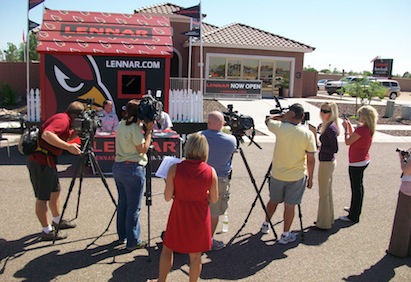Through Lennar Arizona’s “Take it to the House” promotion, people can win tickets and sideline passes to an Arizona Cardinals game by visiting any of the builder’s communities in Phoenix or Tucson.
Kathie McDaniel, vice president of sales and marketing for Lakeland, Fla.-based Highland Homes, spent some of her spare time at the 2010 International Builders’ Show taking in the sights on the Las Vegas strip. One of the things that caught her eye was the flyers being handed out for, shall we say, discreet adult services. She wasn’t interested in the product they were pitching, but the flyers gave her an idea for an inexpensive, effective way to market her communities.
“We reduced our flyer to trading card size,” she says. “It’s the same information as on an 8x11 sheet of paper. Your reaction is to grab something someone is giving you. Plus, retailers are not opposed to having us put them on their counters because they’re so small.”
Costing less than a dime per piece to produce, the postcards are used by all of her sales agents, who are responsible for taking them to places and passing them out. The tactic has been “hugely successful,” McDaniel says. “We use them everywhere. We went out to a parade event and got three sales from that.”
Highland Home’s trading cards are a great example of guerrilla marketing. It’s a technique that is most simply defined as using time, energy, imagination, and knowledge — versus money — to get the word out about your company.
“The real big advantage is that most people think they have to spend a lot of money to get big results,” says Michael Tasner, chief marketing officer of DeBary, Fla.-based Guerrilla Marketing International, the company of Jay Conrad Levinson, who coined the term and is considered the father of guerrilla marketing.
“Guerrilla marketing is thinking outside the box,” Tasner says. “It’s usually low cost and high impact. One of the other key things is that it works 100 percent of the time if you do it correctly. It’s not guesswork. Jay designed all of this based on human psychology and consumer buying behavior.”
A common misconception about guerrilla marketing, Tasner says, is that it’s a shotgun approach to marketing, trying anything and everything, using a strategy once and then moving on. For maximum effect, a guerrilla marketing plan involves a seven-step process that’s about as conventional and thoughtful as you can get. To successfully implement guerrilla marketing, you should:
- Decide on the specific purpose of your marketing. Are you trying to build brand awareness? Drive traffic?
- Identify your competitive advantage — what your company has that no one else has, or what it does better than anyone else.
- Select your specific target market (buyer demographic).
- Identify your niche in the market — what you stand for and the results you’ve produced.
- Clarify your identity. This is more of an emotional element than a competitive advantage or niche, which are more tangible and results-driven. What do you want people to remember you by?
- Commit to a marketing budget as a percentage of gross sales.
- Identify which guerrilla marketing strategies you’re going to use. Put them into a calendar and stick with the plan exactly. “Consistency is something that’s missing from just about every company,” Tasner says.
Another common misconception about guerrilla marketing, Tasner says, is that it’s always done on the cheap. Many times it is, but not always. For example, he considers participation in “Extreme Makeover: Home Edition” as a form of guerrilla marketing. Builders who have done the houses know there’s nothing inexpensive about it. But there’s no denying the buzz created by the show’s arrival in a market or the benefit of connecting with another well-known brand.
That’s been the experience of Lennar Arizona, which is the official home builder of the Arizona Cardinals. This season, the builder is running a “Take it to the House” promotion. People can stop by any Lennar community in Phoenix or Tucson to register for tickets to a home game, with sideline passes and a gift pack from the Cardinals. Together, it’s worth about $750, says Mike Dowell, vice president of marketing for Lennar Arizona.
But that’s not all. If the Cardinals return the opening kick-off for a touchdown, the winner of the tickets also wins a house. It’s already happened once this season.
The goal of the promotion is to increase traffic at the welcome centers at Lennar’s communities. There’s a new registration for each home game, which offers every Lennar community the potential of a steady stream of visitors throughout the fall.
“We wanted to get people out, to show them we’re the builder who has something different and something of interest,” Dowell says. “If they come out to our centers, we’re confident they’ll like what they see.”
The promotion is supported by TV and radio ads, Facebook, and Twitter. To help boost response, Lennar’s sales agents send emails to all of their previous customers and their prospects. “The construction guys go out to shopping centers and businesses in the immediate area to tell people they need to come out and register,” Dowell says. “At worst, you can get sideline passes to the game. They’re great tickets.”
It’s worked well. Traffic has been at three to four times the normal level at some communities and Lennar received a significant amount of press coverage on the couple who won the first house.
An insurance policy covers the cost of the house and any others that are won. “If the Cardinals run it back for a touchdown nine times, it doesn’t cost us anything,” Dowell says.
Leveraging the Web
Of course, the Web offers a wide range of opportunities for guerrilla marketing. McDaniel has made extensive use of PURL direct mail, short for personalized URLs. She uses them in conjunction with a promotion, such as $99 deposit to buy a home. The cards, which cost less than $1 a piece to produce, including postage, are mailed to residents of apartment complexes near their model centers. The URL is tied to the person’s address so the only information that needs to be collected is their phone number.
“Every time we send it out, the response we get is amazing,” McDaniel says. You need to have the staff ready because the phones blow up. Usually we’ll have immediate sales within two to three days.”
Other builders are making good use of website landing pages tied to social media, says Carol Flammer, author of “Social Media for Home Builders.” The landing page generally features a benefit of some kind, such as a drawing for a home improvement center gift card, in exchange for contact information or subscription to a newsletter.
“It’s a great way to increase the number of people you’re allowed to communicate with,” Flammer says. “We’ve seen traffic that comes from social network sites spend two to six minutes on builders’ sites. They’re not tire kickers, so why not ask for their name when they land?”
Most builders have struggled with how to leverage the massive popularity of Facebook the way some other industries have done, Flammer says. “How do you compete with a cup of coffee from Starbucks?” she says. “It’s not easy for builders to give away stuff.”
The North Carolina division of Standard Pacific Homes did just that with its Friends with Furniture promotion, which took advantage of the closure of several model homes to hold drawings for rooms of furniture just for posting a comment on the builder’s Facebook fan page. The promotion won MAME (Major Achievements in Marketing Excellence) awards for best special promotion and best use of social media by a company. This year’s version of the contest has Standard Pacific partnered with a local furniture store; grand prize is a $1,000 gift card. Entrants have to take a picture of a Standard Pacific home, community, or amenity and post it to the company’s fan page — a great way to get prospective buyers out looking at what the builder has to offer. A website (www.friendswithfurniture.com) explains the promotion.
One of the savviest examples of a builder’s use of guerrilla marketing, Flammer says, is Lee Homes’ TLofts, a loft community in Los Angeles. The 84-unit community is located on a heavily traveled street and is surrounded by 7,000 office workers. Marketing firm Red Rocket LA leveraged the white-hot popularity of food trucks, which set up at a different location every day and alert their customers via Twitter. The Kogi Korean barbecue truck was making its debut; Red Rocket contacted the owners and asked if they’d like to park their truck in front of TLofts. Kogi started tweeting their location in the morning. Before the truck arrived, 50 people were waiting in line, steps away from the TLofts sales center.
“Then, we had truck after truck calling us to get on the TLofts schedule,” says Red Rocket vice president Shelley Miller. “Now, the office workers count on it. It’s been hugely successful. You better believe TLofts has sold units because of those trucks.”
25 guerrilla marketing tools you already use
You could be a guerrilla marketer and not even know it. According to Jay Conrad Levinson, the marketing guru who coined the term, many aspects of your business identity are guerrilla marketing tools. Virtually every aspect of your business contributes to your marketing message. The key, says Levinson, is making sure they’re all consistent and reinforce each other.
Here are 25 guerrilla marketing tools you might not even know you have, but already use. (Levinson actually lists 100. His company, Guerrilla Marketing International, was kind enough to give us permission to draw from the list. For the full list, visit www.gmarketing.com.)
- The name of your company
- Your logo
- Company stationery
- Business cards
- Signage
- Your days and hours of operation
- Speaking at events
- Community involvement
- Direct mail letters and postcards
- Association memberships
- On-hold messages
- Customer testimonials
- Company attire
- Marketing plan
- Telephone demeanor
- Your reputation
- Guarantees
- Customer service
- Customer follow-up
- Research studies
- Prospect mailing list
- Newspaper articles
- Word of mouth
- Referral programs
- Yourself and your employees
Food fight! Shaw Flooring makes history
Shaw Flooring is not a builder, but its recent promotion is such a great example of guerrilla marketing, we couldn’t leave it out. To demonstrate that its Anso nylon carpet with RX2 stain resistance can stand up to the worst food messes a family could throw at it, Shaw rolled out about 3,000 square feet of carpet and staged the world’s largest pie fight in Grapevine, Texas.
More than 400 Shaw employees, customers, and guests donned plastic rain ponchos emblazoned with Anso nylon’s marketing slogan — “Anso? Hope so!” — and pelted each other with 1,200 cherry, apple, and chocolate pies. The carpet manufacturer flew in a representative of the Guinness Book of World Records to confirm their spot in the record books.
The important part came after the fight, when a team brought out shovels, scraped off 3,000 pounds of pie crust and filling, and then cleaned the carpet.
The event was attended by more than 500 Shaw retailers and media. “We wanted everyone to see we weren’t making this up,” says Shaw spokesperson Mollie Surratt. “If it can stand up to 1,200 pies, it can stand up to your kids.”
Working with the Guinness organization gave the event instant credibility, Surratt says. “Our best customers are our retailers, so we were looking for a creative, attention-grabbing event. It’s an easy story for people to tell. Guinness has amazing brand awareness.”
Being sensitive to the tough economic times, Shaw gave each pie-fight participant a donation to make to the charity of his or her choice. The company also made a donation to a local affiliate of Feeding America, the nation’s largest domestic hunger-relief charity, to offset the food waste.
The results have been “overwhelming,” says Surratt. The video is posted on Home Depot’s website, as well as on YouTube (search for Anso pie fight). Retailers across the country have point-of-sale materials, as well as scraps of carpet from the pie fight.
“It’s been a viral response,” she says. “Everyone loves the story, everyone relates to Guinness, and everyone relates to food messes in the home.”












